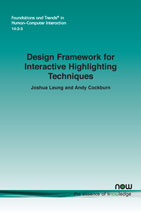Design Framework for Interactive Highlighting Techniques
By Joshua Leung, University of Canterbury, New Zealand, joshua.leung@canterbury.ac.nz | Andy Cockburn, University of Canterbury, New Zealand, andrew.cockburn@canterbury.ac.nz
Abstract
Highlighting techniques are a diverse class of visual communication techniques that make users aware of salient information in a timely manner. Any visual effect can potentially be used and manipulated to create highlighting effects given the right context, making the design space for highlighting techniques broad and rich. Although highlighting techniques are a common and important part of user interfaces, there is a lack of understanding about how to select, apply, and control their effects for achieving the best results.
To address this knowledge gap, we present a new structured design framework – Parametric Control and Construction of Highlights (PCCH) – for describing highlighting techniques in a concise and objective way, using parameters to accurately specify highlighting technique configurations. We then review the current understanding of highlighting techniques, their effects, and prior methods of measuring those effects. We also review underlying human factors that affect how users interact with highlighting techniques.
Design Framework for Interactive Highlighting Techniques
Highlighting techniques are a diverse class of visual communication techniques that make users aware of salient information in a timely manner. Any visual effect can potentially be used and manipulated to create highlighting effects given the right context, which makes the design space for highlighting techniques broad and rich. Although highlighting techniques are a common and important part of user interfaces, there is a lack of understanding about how to select, apply, and control their effects to achieve the best results. This monograph lays the foundations for addressing this knowledge gap and proposes a new framework.
The authors review the current understanding of highlighting techniques, their effects, and prior methods of measuring those effects. They also review underlying human factors that affect how users interact with highlighting techniques. To address the knowledge gap, they present a new structured design framework – Parametric Control and Construction of Highlights (PCCH) – for describing highlighting techniques in a concise and objective way, using parameters to accurately specify highlighting technique configurations.
